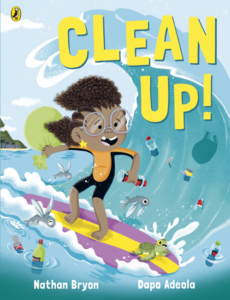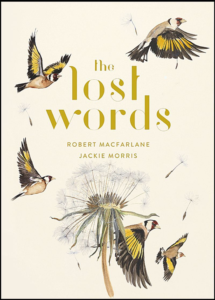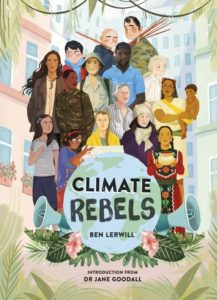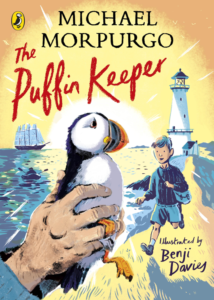| Recommended Reads | Download PDF |
Environmental Children’s Literature – A Catalyst for Taking Action
Introduced by David Valente
The ELT Footprint Community, with its award-winning website (British Council ELTons, 2020) and social media groups, aims to reduce the environmental footprint of the ELT profession as well as to mainstream climate-change awareness in ELT. A visit to the site and buzzing social media channels reflects a highly engaged community of professionals, sharing pedagogical ideas and good practice regarding environmental awareness and action taking. The Recommended Reads in this edition contribute to this important work by shining a light on the affordances of embedding environmental consciousness in English language education in school contexts, accompanied by creative ideas for using children’s literature formats with environmental themes.
This reflects a critical literacy stance, which according to Vasquez et al. (2013, p. 18), emphasizes ‘understanding one’s own involvement’, conceived in terms of taking action beyond the classroom, for both English teachers and their learners. Encouragingly, there is growing scholarly interest which supports practitioners with theory and practice to integrate eco-activism into classroom practice by exploring children’s literature with an ecocritical lens (see, e.g., Bartosch & Grimm, 2014; Goga et al., 2018). However, there still appears to be a dearth of focus on engagement in this domain by English teachers of the under 12s in particular (see, however, Bland, 2014). Perhaps this is due to the common misconception that the political advocacy realm lacks age-appropriacy, resulting in avoidance by primary English language teachers in some contexts.
Returning to Vasquez et al.’s conceptualization – which posits that taking action involves a shift in learners’ perspectives which would manifest as deeper engagement in environmental concerns – a key consideration arises regarding how to mediate this perceptions and feelings-based process in the English language classroom. In responding to this question for teachers and teacher educators alike, this edition’s Recommended Reads position children’s literature formats as potential catalysts for environmental action taking. They comprise four different engaging formats: a picturebook, a biographical stories collection, a book of spells-as-poems and a chapter book, suitable for English language lessons with varied learner age ranges and proficiency levels.
Furthermore, the pedagogical suggestions made by the contributors offer extensive ideas for deep reading which are creative, cross-curricular and encourage eco-activism on the part of children and teenagers in the school context and most importantly, beyond.
References
Bartosch, R., & Grimm, S. (Eds.) (2014). Teaching environments. Ecocritical encounters. Peter Lang.
Bland, J. (2014). Ecocritical sensitivity with multimodal texts in the EFL/ESL literature classroom. In R. Bartosch & S. Grimm (Eds.), Teaching environments. Ecocritical encounters (pp. 75-96). Peter Lang.
Goga, N., Guanio-Uluru, L., Hallås, B. O., & Nyrnes, A. (2018). Ecocritical perspectives on children’s texts and cultures. Palgrave Macmillan.
Vasquez, V. M., Tate, S. L., & Harste, J. C. (2013). Negotiating critical literacies with teachers. Theoretical foundations and pedagogical resources for pre-service and in-service contexts. Routledge.
Useful Resources
The ELT Footprint Community website: https://eltfootprint.org/ and Facebook Group: https://www.facebook.com/groups/eltfootprint
Bryon, Nathan & Adeola, Dapo (illus.) (2020)
Clean Up!
London: Puffin
Recommended by Griselda Beacon
Rocket is back! The 9-year-old protagonist of the award-winning picturebook, Look Up! (2019), featured in the previous Recommended Reads for Children’s Literature in English Language Education, returns to share her new adventures in the Caribbean. Clean Up! is the second picturebook in a series written by Nathan Bryon and illustrated by Dapo Adeola, and centres on her beach clean-up to save the sea life from plastic waste pollution. The series introduces current social issues relevant to wider educational goals in primary English education globally; for example, the themes of sustainable education, racial and gender equality are embedded in Rocket’s stories, which are engaging, relatable and enjoyable and well-suited for primary learners of English (circa 6 – 10 years, depending on context).
In Clean Up!, Rocket visits her grandparents in the Caribbean with her mum and her older brother Jamal. While on holiday, she surfs with her grandma, makes sandcastles, discovers whale watching and helps in her grandparents’ animal sanctuary. When she rescues a baby turtle entangled in plastic, she learns about sea pollution and how plastic ruins sea life. This leads to her taking action and Rocket organizes a huge beach clean-up with everybody as part of the crew, which is a great success. They then recycle all the rubbish by transforming it into artistic rubbish bins for the beach.
This is an ideal picturebook for children learning English as another language, as it includes themes and topics commonly found in primary English, such as holidays, sea animals and family life, but usefully extends this by incorporating global citizenship and values education. Clean Up! can be used to explore the United Nations Sustainable Development Goals (2015), life below water (Goal 14) and life on land (Goal 15), raising children’s awareness of ways to contribute toward these goals. For example, in the story plots, whale-watching provides options for eco-friendly tourists, animal sanctuaries respect animal rights, community actions such as beach clean-up campaigns develop ecological consciousness, and artistic projects shine a light on the transformative outcome of collaborative work. The illustrations can also be mediated during booktalk to sensitize children to the need for gender equality, collaborative action taking, while also contributing to the decentring of whiteness in children’s literature. Rocket’s love for learning supports girls in science and her gender-neutral clothes and behaviour subvert traditional gender roles and stereotyping. Her commitment to civic action responds to the need for collaborative community initiatives and her affirming Afro hairstyle represents self-acceptance, making her ethnicity visible and challenging the erasure of people of colour interacting with nature in children’s literature (Ramdarshan Bold, 2019).
The story can also function as a springboard for cross-curricular projects and actions within the community. Creative teaching ideas include discovering the animals and their habitats in the illustrations, making nonfiction mini books for a sea animals classroom library, organizing a school campaign promoting the three ‘Rs’ – Reduce, Reuse, Recycle, creating multilingual posters in English and in the children’s own languages that promote clean spaces to be displayed in the neighbourhood – and making artistic rubbish bins for the school from recyclable materials. I highly recommend Clean Up!, since meeting Rocket and vicariously engaging with her adventures is a real learning experience for children. Her energetic and effervescent attitude is captivating, and children can learn about sea life and protecting the environment, they can also be inspired to make their mark in the world, and all the while, they are learning English.
References
Ramdarshan Bold, M. (2019). Representation of people of colour among children’s book authors and illustrators. Book Trust. https://www.booktrust.org.uk/what-we-do/programmes-and-campaigns/booktrust-represents/representation-of-people-of-colour-among-childrens-book-authors-and-illustrators/
United Nations. (2015). Sustainable development goals: 17 goals to transform our world. https://www.un.org/sustainabledevelopment/sustainable-development-goals/
Griselda Beacon is a teacher of English with an MA in Literature and Foreign Language Teaching from Philipps-Universität, Marburg, Germany. She is co-author of Together (Oxford University Press), an English coursebook series developed for Argentina, and a teacher trainer for the Norwich Institute for Language Education (NILE) in the UK. Griselda regularly holds picturebook read-aloud sessions for children and teaches on a children’s literature course at IESLVJRF, a teacher education college in Buenos Aires, Argentina.
Macfarlane, Robert & Morris, Jackie (illustrator) (2017)
The Lost Words: A Spell Book
London: Hamish Hamilton
Recommended by Emma L. Pratt
When I was asked to recommend a book focusing on ecological concerns and our relationship as humans with the world that we are part of, my natural go-to is the literature of my own country, Aotearoa, New Zealand. There, we have our way, ‘our language’, connections to the world that are specific to our cultures, stories, struggles and experiences. I am sure you will have yours too. However, I then thought of another book that has moved me in its utter sincerity and dedication to the environment that exists right outside my window in Cambridge, UK, that I am getting to know. I want to recommend this book because it is an example of how a local person speaks about a local concern and a natural world that they know intimately. In fact, the author lives near me, and is a lecturer in English at Emmanuel College, Cambridge. When he composed these poems, he was looking at the very landscape that I currently walk through. They are poems about the simple quiet things that happen right in front of our windows, in our hedgerows, in the neighbouring field or meadow, a clump of grass or the woods and the river that meanders through this very town. I hope the premise of the book will inspire secondary-school English teachers and learners to look at what is happening directly around them where they are.
The Lost Words: A Spell Book is a book of conjuring spells, as the writer calls it, that take the form of acrostic poems. They are rich in alliteration, wordplay, onomatopoeia, and compound adjectives, making these poems superbly authentic sources for creative language noticing. The book came into being as a protest against the removal of words from a children’s dictionary because they were deemed as too infrequent in a British child’s contemporary world. Dandelion, otter, bramble, and acorn were among the words removed. When children in inner-city British schools were asked in a survey to identify an acorn or an otter, many could not, yet they could successfully identify various Pokémon species. The Lost Words is a protest against the disappearance of wilderness, of outdoor play and wild childhood. Of exploring woods, muddy ditches and long grass to know the creatures and intricate ecosystems that exist all around us. Alongside the book, there have been several examples of action taking in the local and wider community. A campaign to have the book read to all young students in the United Kingdom was launched. Songs were released by local artists who put Macfarlane’s words to music or created their own responses to the lost words, conjuring them back into existence. As Robert Macfarlane has maintained, you can’t love or empathize with something you can’t identify and name. Teachers of English and their learners can discover numerous videos on YouTube about the action-orientated projects sparked by this book by searching and using the keywords: the lost words, the lost spells, spell songs. A beautiful, freely downloadable PDF teaching resource of activities has also been created around the book: https://www.sustainablelearning.com/resource/lost-words
I would recommend this book and the accompanying multi-faceted and multi-disciplinary environmental campaigns that have accompanied it as a springboard for exploring poetry and the sounds of words. It could also be used when exploring children’s own local environments through creative writing, identifying local birds, designing, or creating habitats for local species, outdoor wild play, free play or even discovering the mathematics of a dandelion! The beautifully finished watercolour images and gold leaf illustrations by Jackie Morris are faithful renderings of creatures and plants that are a work of art in themselves.
I encourage teachers and learners of English to find out what is happening locally, right on your doorstep, along the path to your house or apartment. The following ‘big questions’ could be meaningfully posed during post-reading stages in lessons on the book to spark learners’ deep thinking about – and foster empathy with – the environment. Which words of the natural world are being forgotten in your languages? What connections do you have to the world outside your doors? What are your stories? What poems and spells can you create to conjure up the natural world around you?
Emma L. Pratt is a teacher educator and director of ELTCampus, an online training platform for English language teachers. She is also a visual artist who has been working for the last 20 years with an arts practice that spans painting, drawing, video, and the spoken word. The natural world, place, connection, and identity are recurrent themes in her work that draws deeply on cultural perspectives emanating from the South Pacific.
Lerwill, Ben (2020)
Climate Rebels
Illustrated by Masha Ukhova, Stephanie Son, Chellie Carroll, Hannah Peck & Iratxe López de Munáin
London: Puffin
Recommended by Aleksandra Popovski
Climate Rebels is a collection of 25 brief biographies about today’s environmental activists who devote their lives to the fight for the planet’s survival. The book begins with an interview with one of the most famous activists, Jane Goodall, whose work with chimpanzees in Tanzania, East Africa, and environmental issues in general has inspired numerous other people to engage with the protection of endangered species and nature conservation. There are also stories about other wildlife and climate champions, such as Sir David Attenborough, Greta Thunberg, the founders of Greenpeace, as well as some perhaps lesser-known heroes like Ridhima Pandey, an activist against climate change from India, Len Peters, a turtle protector from Trinidad, William Kamkwamba, who is a wind turbine builder from Malawi, and The Black Mambas, an all-female anti-poaching group from South Africa. Regardless of their level of fame, these rebels have a common goal – saving Planet Earth and invoking action taking in others, especially young people. They are true rebels because their work takes considerable time, effort, and strength to fight laws and regulations, but crucially, they fight to change perceptions of nature and its importance. Although these biographical stories are short, they provide the young reader with an opportunity to get to know the rebels, from their childhood years to their current work.
The collection is a rich source of texts that can be used as basis for lessons in the English language classroom. Learners could further research the featured rebels and the issues connected to their activism, such as climate change, endangered species, or sustainability. This could evoke feelings of empathy and understanding, and as the language style is both natural and direct, this book would most suit lower-secondary learners of English (ca. 12 years). For example, the story of the poacher patrollers in The Black Mambas biography includes high-frequency grammatical structures and does not contain too many complex sentences. Moreover, the visual elements make the collection even more attractive, such as the illustration accompanying Ridhima’s story, which features the protagonist in the centre holding a dog and is set in different shades of brown and blue. The street scene is inspired by a small town in India and learners could notice details and imagine the lives of the people ‘beyond the frame’. This could act as a springboard for explorations of urban and/or rural settings in India, the related environmental challenges, and potential actions. For example, children could research Ridhma’s experience of the serious flood in her province and consider how they would feel and what actions they would take if something similar happened in the place where they live.
The stories could also serve as springboards for intercultural project work on different countries and ecological issues. The learners could choose a country from the stories and explore its geographical features, cultures and communities. They could further research its environmental issues and brainstorm ways that children in that country could take action. Their ideas could be creatively written and displayed as eco-warrior’s guides that help raise awareness and call learners to act in their own contexts. Their ideas could also be ‘published’ using Padlet or Canva to create colourful digital posters to be shared via an online exchange platform such as eTwinning.
Learners could additionally develop their oral fluency by role-playing interviews with the rebels. They could collaboratively brainstorm questions for each rebel as well as possible responses. The stories provide the content for such responses, but children can also add their own ideas and opinions for deeper and multiple interpretations and increased language stretching. Working in pairs, one learner plays the role of a reporter and the other plays the role of the activist. And the learners could extend their creative repertoires further by interviewing an endangered animal, thereby giving a much-needed voice to those customarily silenced. The children could first research the animal, then write questions and responses for the interview based on the information collected; and using the app Chatterpix, they could upload a photo and then record themselves speaking as the endangered animal, thus encouraging learners to consider environmental issues from the perspective of those most impacted.
The collection ends with a powerful message: ‘Like the people in this book, you too have the power to make a difference. So, what will you choose to do?’ I believe that ELT is not merely about learning a language, as this journal so richly highlights. It involves the need to raise learners’ awareness not only about what the world is like, but what the world could be like. Children need to be empowered to take action and it is incumbent on our wider educator remit to encourage and nurture young people’s interests in socially relevant topics and issues, as present (and future) members of the global village.
Aleksandra Popovski is a teacher of English based in North Macedonia. She is particularly interested in using children’s literature in English language education as a tool for exploring issues such as social (in)justice, diversity, and inclusion. Aleksandra is especially passionate about ‘no one is a single story’, i.e., writing stories about countries, cultures, and communities that are routinely excluded from published ELT materials.
Morpurgo, Michael (2020)
The Puffin Keeper
Illustrated by Benji Davies
London: Penguin Random House
Recommended by Jane Cleary
The Puffin Keeper is set in Britain around the time of World War Two. The two main characters first meet one stormy night – Benjamin Postlethwaite rescues Allen Davies (a young boy at the time) from drowning as his ship sinks off the coast of Puffin Island where Benjamin is the lighthouse keeper. We then follow Allen’s life through a difficult childhood, the war, and numerous returns to Puffin Island. It is on the island that Allen and Benjamin rescue an injured puffin, nurture it back to health and release it. Until then, puffins had not been seen on the island for more than 100 years, but after its release more arrive until Puffin Island is a thriving community again.
The language, organization and themes make The Puffin Keeper especially suitable for lower-secondary English learners (ca. 11-14 years). A chapter book written in a narrative style with some direct speech, the language is very accessible. At 91 pages and ten chapters, with charming watercolours on almost every page, it is extensive and challenging enough for lower-secondary level whilst also being manageable. Puffins are key to the story; we learn about their appearance, diet, behaviour and habitat, which lends itself to a fact-file activity. The learners could collect and organize the information provided in the story into a puffin fact file, using these pages from the book: for appearance, see the description including ‘over-sized beak’ (p. 51) alongside the illustration of a puffin (p. 52); for diet, see ‘he likes sand eels’ (p. 53); for behaviour and habitat, note: ‘the sea all around the island was dotted with floating puffins…I could see them in their hundreds now up at the far end of the island, on the headland above the cliffs, flying in, flying out, but most of them just standing there looking out to sea’ (p. 85); and for habitat: ‘they … found their old burrows’ (p. 86). The learners can use further sources such as on this National Geographic Kids site https://www.natgeokids.com/uk/discover/animals/birds/puffin-facts/ to enhance the fact file. Researching this may help learners to develop an appreciation and respect for puffins whilst gathering information from different sources will help develop information literacy.
Working with emotions and empathy, children might visualize being the puffin when it is released. The teacher could show the children the striking illustration of the puffin’s release (under the dust jacket in the hardback edition) and on pp. 58-59, they close their eyes, and the teacher reads the section about the puffin’s release (pp. 56-60) and then the children imagine that they are the puffin. Using a guided visualization, the teacher can ask children to contemplate questions such as ‘What can they see and hear?’ ‘How do they feel?’ The children can then creatively express their feelings in writing, speaking or drama activities.
The ecological themes can then be explored through deep reading activities. The teacher could ask learners to describe what took place between p. 42, where we learn that there had not been puffins on the island ‘for a hundred years or more’, to the point at the end of the book when Allen and Benjamin ‘stood there with the puffins all around … . It’s Puffin Island again’ (pp. 86-87). Learners could discuss ideas in groups about why the puffins might have left, and why they might have returned; or whether they think humans had (or have) a role to play; and what we can do now and, in the future, to protect puffins. The children might also discuss what problems and benefits humans bring to the birds. An interesting angle could be that the children reflect on and share ideas to develop oral fluency by justifying their views about ‘The Puffin Keeper’s Law’ – which is ‘We leave the puffins be’ (p. 90) – and what this means.
I can highly recommend this book as an accessible and engaging story for English language learning which encourages children’s fascination and respect for the natural world by heightening their environmental consciousness.
Jane Cleary is a Senior Lecturer in English Language Teaching and Teaching English to Speakers of Other Languages at The University of Central Lancashire, United Kingdom. She has worked in ELT for over 25 years and has an interest in using literature and stories for language learning and is a volunteer educator with the Hands Up Project (https://handsupproject.org/the-hands-up-story/), using story and drama to teach English online with children in Palestine.





